An Analysis of Malaysia's Middle-Income Challenge (ECN70104)
VerifiedAdded on 2023/04/11
|15
|3365
|478
Report
AI Summary
This report delves into Malaysia's persistent struggle to transition from a middle-income to a high-income nation, examining the 'middle-income trap' phenomenon. The analysis begins with an overview of Malaysia's economic evolution since independence, highlighting its shift from a commodity-based economy to a services-oriented one. The report defines the middle-income trap, emphasizing the stagnation experienced by countries like Malaysia that have been unable to achieve high-income status despite initial economic growth. It explores various factors contributing to this trap, including the slow growth of Total Factor Productivity (TFP), insufficient investment in Research & Development (R&D), and a lack of diversification in exports. The paper also references studies comparing Malaysia's economic performance to other East Asian nations and discusses the role of foreign labor and multinational companies. The report further examines the role of innovation, patent applications, and the impact of foreign direct investment. Finally, it suggests potential strategies for Malaysia to overcome these challenges and achieve high-income status. The report uses figures and data from various sources like World Bank and Asian Development Bank to support the arguments.
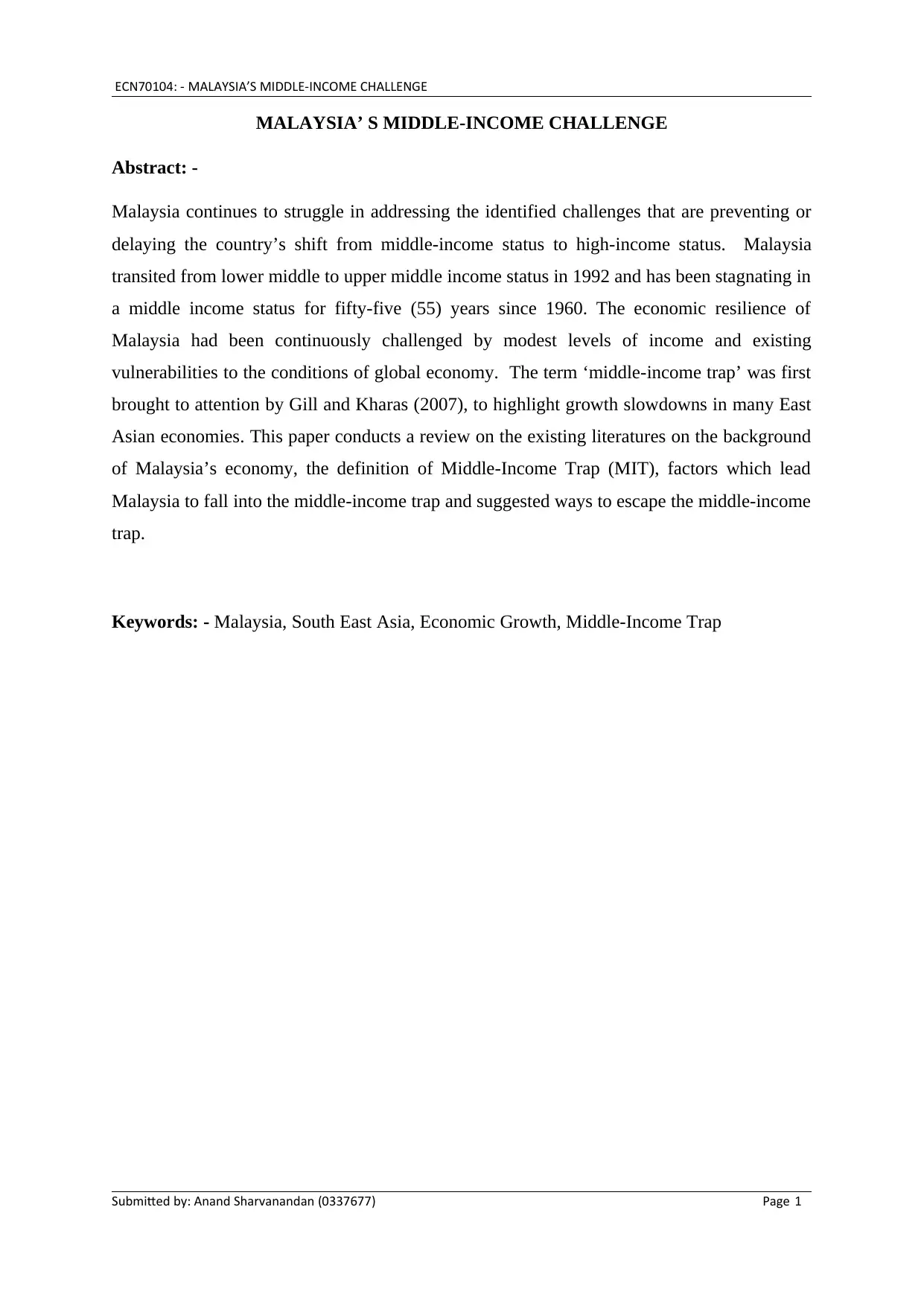
ECN70104: - MALAYSIA’S MIDDLE-INCOME CHALLENGE
MALAYSIA’ S MIDDLE-INCOME CHALLENGE
Abstract: -
Malaysia continues to struggle in addressing the identified challenges that are preventing or
delaying the country’s shift from middle-income status to high-income status. Malaysia
transited from lower middle to upper middle income status in 1992 and has been stagnating in
a middle income status for fifty-five (55) years since 1960. The economic resilience of
Malaysia had been continuously challenged by modest levels of income and existing
vulnerabilities to the conditions of global economy. The term ‘middle-income trap’ was first
brought to attention by Gill and Kharas (2007), to highlight growth slowdowns in many East
Asian economies. This paper conducts a review on the existing literatures on the background
of Malaysia’s economy, the definition of Middle-Income Trap (MIT), factors which lead
Malaysia to fall into the middle-income trap and suggested ways to escape the middle-income
trap.
Keywords: - Malaysia, South East Asia, Economic Growth, Middle-Income Trap
Submitted by: Anand Sharvanandan (0337677) Page 1
MALAYSIA’ S MIDDLE-INCOME CHALLENGE
Abstract: -
Malaysia continues to struggle in addressing the identified challenges that are preventing or
delaying the country’s shift from middle-income status to high-income status. Malaysia
transited from lower middle to upper middle income status in 1992 and has been stagnating in
a middle income status for fifty-five (55) years since 1960. The economic resilience of
Malaysia had been continuously challenged by modest levels of income and existing
vulnerabilities to the conditions of global economy. The term ‘middle-income trap’ was first
brought to attention by Gill and Kharas (2007), to highlight growth slowdowns in many East
Asian economies. This paper conducts a review on the existing literatures on the background
of Malaysia’s economy, the definition of Middle-Income Trap (MIT), factors which lead
Malaysia to fall into the middle-income trap and suggested ways to escape the middle-income
trap.
Keywords: - Malaysia, South East Asia, Economic Growth, Middle-Income Trap
Submitted by: Anand Sharvanandan (0337677) Page 1
Paraphrase This Document
Need a fresh take? Get an instant paraphrase of this document with our AI Paraphraser
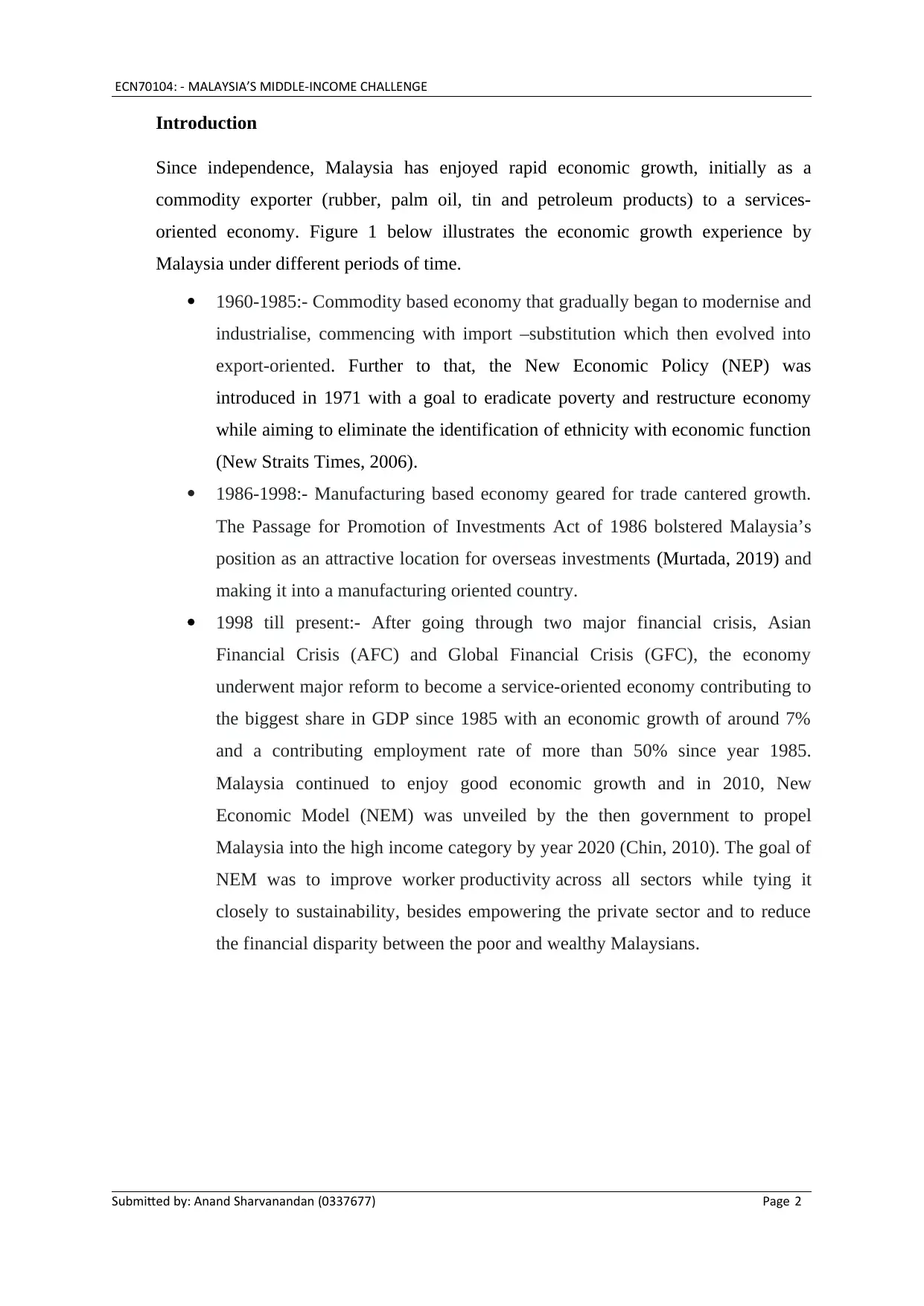
ECN70104: - MALAYSIA’S MIDDLE-INCOME CHALLENGE
Introduction
Since independence, Malaysia has enjoyed rapid economic growth, initially as a
commodity exporter (rubber, palm oil, tin and petroleum products) to a services-
oriented economy. Figure 1 below illustrates the economic growth experience by
Malaysia under different periods of time.
1960-1985:- Commodity based economy that gradually began to modernise and
industrialise, commencing with import –substitution which then evolved into
export-oriented. Further to that, the New Economic Policy (NEP) was
introduced in 1971 with a goal to eradicate poverty and restructure economy
while aiming to eliminate the identification of ethnicity with economic function
(New Straits Times, 2006).
1986-1998:- Manufacturing based economy geared for trade cantered growth.
The Passage for Promotion of Investments Act of 1986 bolstered Malaysia’s
position as an attractive location for overseas investments (Murtada, 2019) and
making it into a manufacturing oriented country.
1998 till present:- After going through two major financial crisis, Asian
Financial Crisis (AFC) and Global Financial Crisis (GFC), the economy
underwent major reform to become a service-oriented economy contributing to
the biggest share in GDP since 1985 with an economic growth of around 7%
and a contributing employment rate of more than 50% since year 1985.
Malaysia continued to enjoy good economic growth and in 2010, New
Economic Model (NEM) was unveiled by the then government to propel
Malaysia into the high income category by year 2020 (Chin, 2010). The goal of
NEM was to improve worker productivity across all sectors while tying it
closely to sustainability, besides empowering the private sector and to reduce
the financial disparity between the poor and wealthy Malaysians.
Submitted by: Anand Sharvanandan (0337677) Page 2
Introduction
Since independence, Malaysia has enjoyed rapid economic growth, initially as a
commodity exporter (rubber, palm oil, tin and petroleum products) to a services-
oriented economy. Figure 1 below illustrates the economic growth experience by
Malaysia under different periods of time.
1960-1985:- Commodity based economy that gradually began to modernise and
industrialise, commencing with import –substitution which then evolved into
export-oriented. Further to that, the New Economic Policy (NEP) was
introduced in 1971 with a goal to eradicate poverty and restructure economy
while aiming to eliminate the identification of ethnicity with economic function
(New Straits Times, 2006).
1986-1998:- Manufacturing based economy geared for trade cantered growth.
The Passage for Promotion of Investments Act of 1986 bolstered Malaysia’s
position as an attractive location for overseas investments (Murtada, 2019) and
making it into a manufacturing oriented country.
1998 till present:- After going through two major financial crisis, Asian
Financial Crisis (AFC) and Global Financial Crisis (GFC), the economy
underwent major reform to become a service-oriented economy contributing to
the biggest share in GDP since 1985 with an economic growth of around 7%
and a contributing employment rate of more than 50% since year 1985.
Malaysia continued to enjoy good economic growth and in 2010, New
Economic Model (NEM) was unveiled by the then government to propel
Malaysia into the high income category by year 2020 (Chin, 2010). The goal of
NEM was to improve worker productivity across all sectors while tying it
closely to sustainability, besides empowering the private sector and to reduce
the financial disparity between the poor and wealthy Malaysians.
Submitted by: Anand Sharvanandan (0337677) Page 2
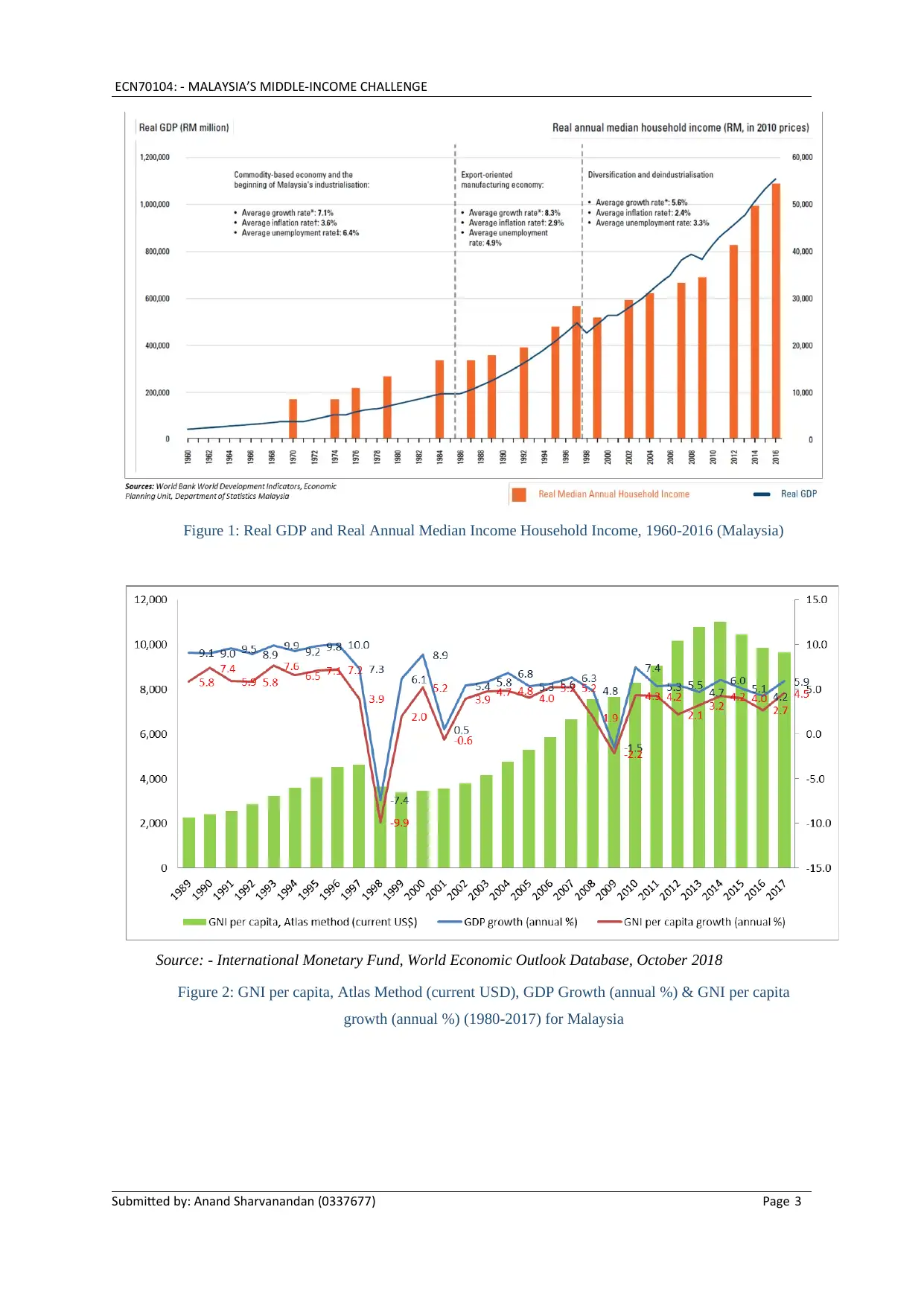
ECN70104: - MALAYSIA’S MIDDLE-INCOME CHALLENGE
Figure 1: Real GDP and Real Annual Median Income Household Income, 1960-2016 (Malaysia)
Source: - International Monetary Fund, World Economic Outlook Database, October 2018
Figure 2: GNI per capita, Atlas Method (current USD), GDP Growth (annual %) & GNI per capita
growth (annual %) (1980-2017) for Malaysia
Submitted by: Anand Sharvanandan (0337677) Page 3
Figure 1: Real GDP and Real Annual Median Income Household Income, 1960-2016 (Malaysia)
Source: - International Monetary Fund, World Economic Outlook Database, October 2018
Figure 2: GNI per capita, Atlas Method (current USD), GDP Growth (annual %) & GNI per capita
growth (annual %) (1980-2017) for Malaysia
Submitted by: Anand Sharvanandan (0337677) Page 3
⊘ This is a preview!⊘
Do you want full access?
Subscribe today to unlock all pages.

Trusted by 1+ million students worldwide
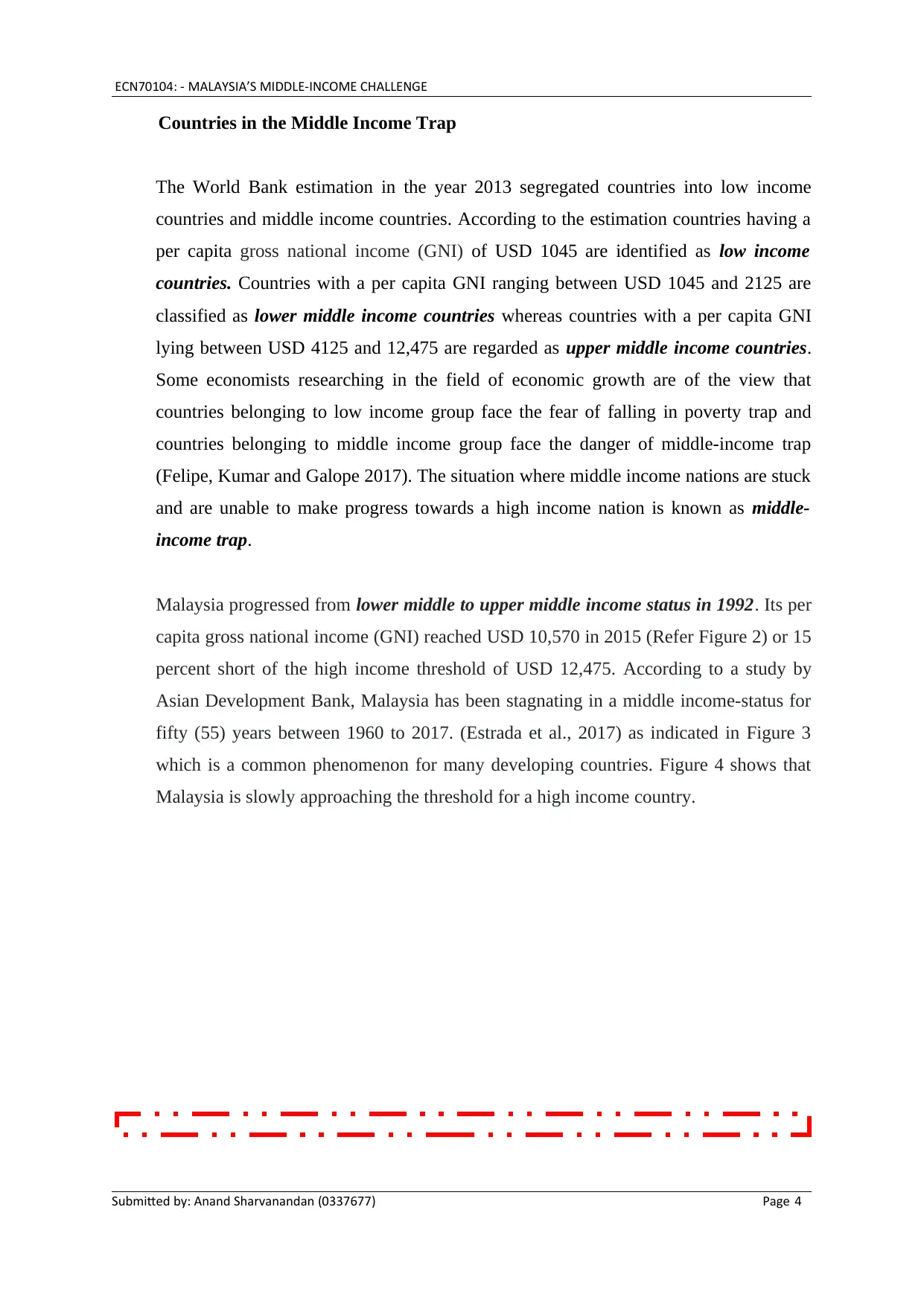
ECN70104: - MALAYSIA’S MIDDLE-INCOME CHALLENGE
Countries in the Middle Income Trap
The World Bank estimation in the year 2013 segregated countries into low income
countries and middle income countries. According to the estimation countries having a
per capita gross national income (GNI) of USD 1045 are identified as low income
countries. Countries with a per capita GNI ranging between USD 1045 and 2125 are
classified as lower middle income countries whereas countries with a per capita GNI
lying between USD 4125 and 12,475 are regarded as upper middle income countries.
Some economists researching in the field of economic growth are of the view that
countries belonging to low income group face the fear of falling in poverty trap and
countries belonging to middle income group face the danger of middle-income trap
(Felipe, Kumar and Galope 2017). The situation where middle income nations are stuck
and are unable to make progress towards a high income nation is known as middle-
income trap.
Malaysia progressed from lower middle to upper middle income status in 1992. Its per
capita gross national income (GNI) reached USD 10,570 in 2015 (Refer Figure 2) or 15
percent short of the high income threshold of USD 12,475. According to a study by
Asian Development Bank, Malaysia has been stagnating in a middle income-status for
fifty (55) years between 1960 to 2017. (Estrada et al., 2017) as indicated in Figure 3
which is a common phenomenon for many developing countries. Figure 4 shows that
Malaysia is slowly approaching the threshold for a high income country.
Submitted by: Anand Sharvanandan (0337677) Page 4
Countries in the Middle Income Trap
The World Bank estimation in the year 2013 segregated countries into low income
countries and middle income countries. According to the estimation countries having a
per capita gross national income (GNI) of USD 1045 are identified as low income
countries. Countries with a per capita GNI ranging between USD 1045 and 2125 are
classified as lower middle income countries whereas countries with a per capita GNI
lying between USD 4125 and 12,475 are regarded as upper middle income countries.
Some economists researching in the field of economic growth are of the view that
countries belonging to low income group face the fear of falling in poverty trap and
countries belonging to middle income group face the danger of middle-income trap
(Felipe, Kumar and Galope 2017). The situation where middle income nations are stuck
and are unable to make progress towards a high income nation is known as middle-
income trap.
Malaysia progressed from lower middle to upper middle income status in 1992. Its per
capita gross national income (GNI) reached USD 10,570 in 2015 (Refer Figure 2) or 15
percent short of the high income threshold of USD 12,475. According to a study by
Asian Development Bank, Malaysia has been stagnating in a middle income-status for
fifty (55) years between 1960 to 2017. (Estrada et al., 2017) as indicated in Figure 3
which is a common phenomenon for many developing countries. Figure 4 shows that
Malaysia is slowly approaching the threshold for a high income country.
Submitted by: Anand Sharvanandan (0337677) Page 4
Paraphrase This Document
Need a fresh take? Get an instant paraphrase of this document with our AI Paraphraser
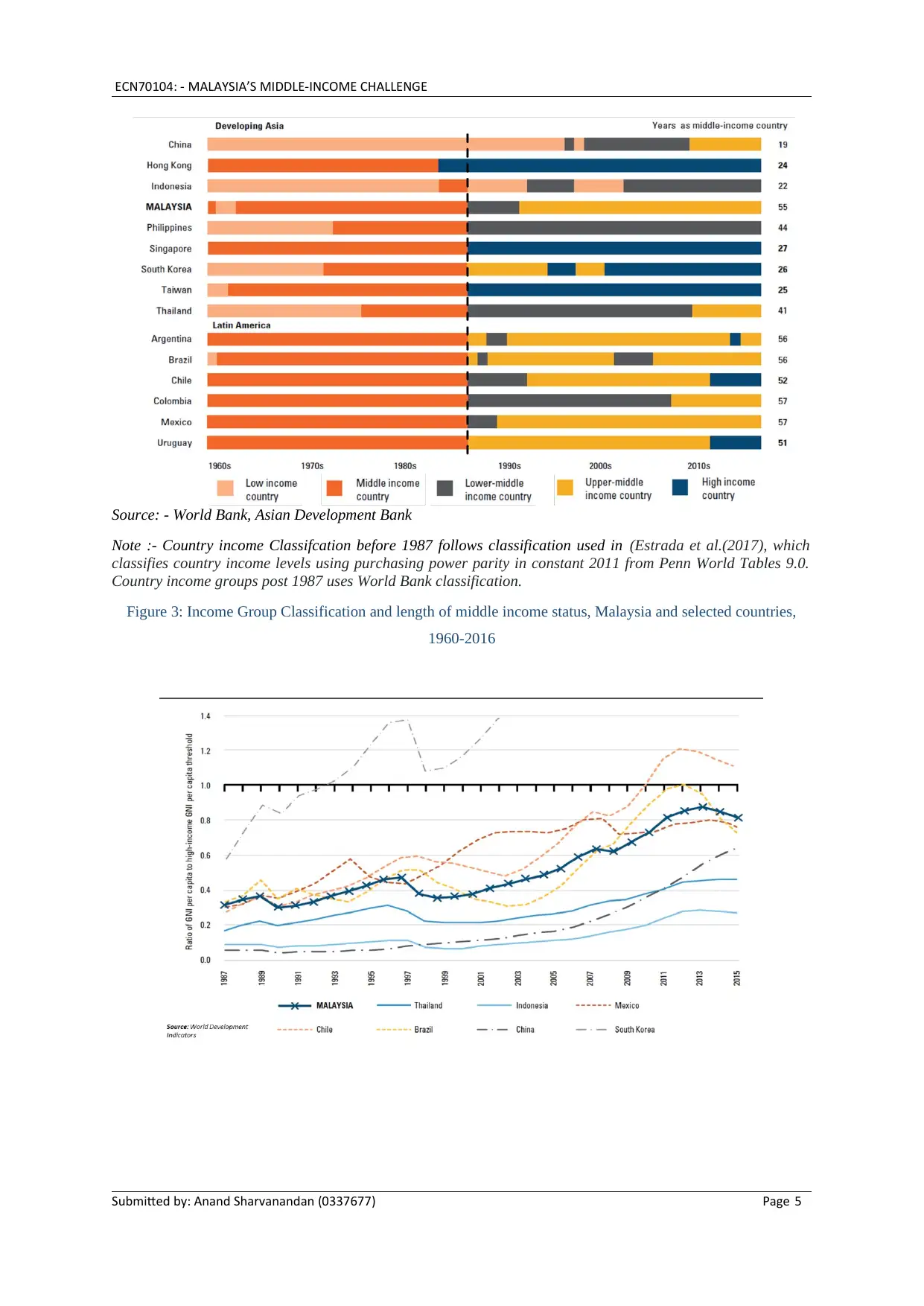
ECN70104: - MALAYSIA’S MIDDLE-INCOME CHALLENGE
Source: - World Bank, Asian Development Bank
Note :- Country income Classifcation before 1987 follows classification used in (Estrada et al.(2017), which
classifies country income levels using purchasing power parity in constant 2011 from Penn World Tables 9.0.
Country income groups post 1987 uses World Bank classification.
Figure 3: Income Group Classification and length of middle income status, Malaysia and selected countries,
1960-2016
Submitted by: Anand Sharvanandan (0337677) Page 5
Source: - World Bank, Asian Development Bank
Note :- Country income Classifcation before 1987 follows classification used in (Estrada et al.(2017), which
classifies country income levels using purchasing power parity in constant 2011 from Penn World Tables 9.0.
Country income groups post 1987 uses World Bank classification.
Figure 3: Income Group Classification and length of middle income status, Malaysia and selected countries,
1960-2016
Submitted by: Anand Sharvanandan (0337677) Page 5
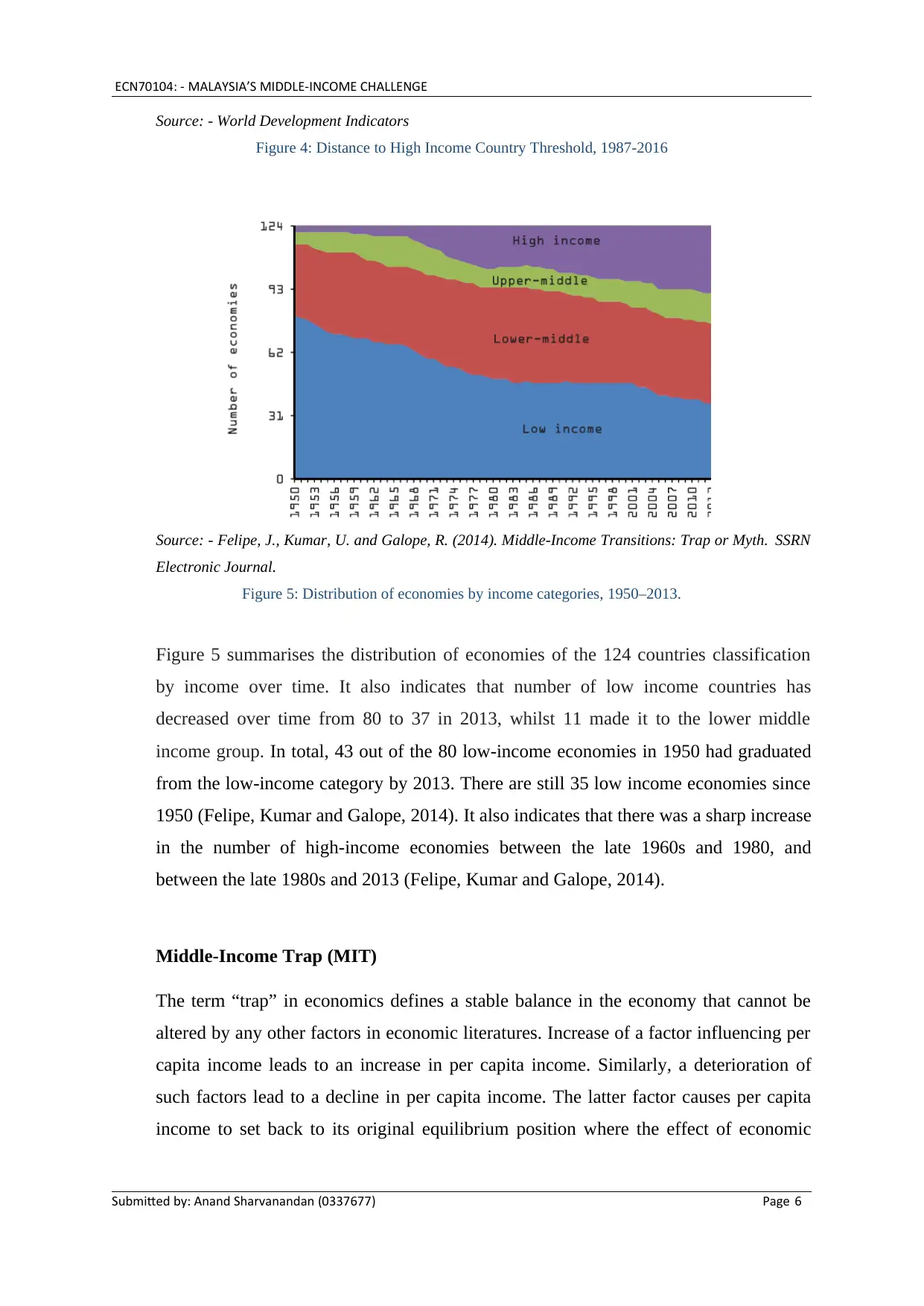
ECN70104: - MALAYSIA’S MIDDLE-INCOME CHALLENGE
Source: - World Development Indicators
Figure 4: Distance to High Income Country Threshold, 1987-2016
Source: - Felipe, J., Kumar, U. and Galope, R. (2014). Middle-Income Transitions: Trap or Myth. SSRN
Electronic Journal.
Figure 5: Distribution of economies by income categories, 1950–2013.
Figure 5 summarises the distribution of economies of the 124 countries classification
by income over time. It also indicates that number of low income countries has
decreased over time from 80 to 37 in 2013, whilst 11 made it to the lower middle
income group. In total, 43 out of the 80 low-income economies in 1950 had graduated
from the low-income category by 2013. There are still 35 low income economies since
1950 (Felipe, Kumar and Galope, 2014). It also indicates that there was a sharp increase
in the number of high-income economies between the late 1960s and 1980, and
between the late 1980s and 2013 (Felipe, Kumar and Galope, 2014).
Middle-Income Trap (MIT)
The term “trap” in economics defines a stable balance in the economy that cannot be
altered by any other factors in economic literatures. Increase of a factor influencing per
capita income leads to an increase in per capita income. Similarly, a deterioration of
such factors lead to a decline in per capita income. The latter factor causes per capita
income to set back to its original equilibrium position where the effect of economic
Submitted by: Anand Sharvanandan (0337677) Page 6
Source: - World Development Indicators
Figure 4: Distance to High Income Country Threshold, 1987-2016
Source: - Felipe, J., Kumar, U. and Galope, R. (2014). Middle-Income Transitions: Trap or Myth. SSRN
Electronic Journal.
Figure 5: Distribution of economies by income categories, 1950–2013.
Figure 5 summarises the distribution of economies of the 124 countries classification
by income over time. It also indicates that number of low income countries has
decreased over time from 80 to 37 in 2013, whilst 11 made it to the lower middle
income group. In total, 43 out of the 80 low-income economies in 1950 had graduated
from the low-income category by 2013. There are still 35 low income economies since
1950 (Felipe, Kumar and Galope, 2014). It also indicates that there was a sharp increase
in the number of high-income economies between the late 1960s and 1980, and
between the late 1980s and 2013 (Felipe, Kumar and Galope, 2014).
Middle-Income Trap (MIT)
The term “trap” in economics defines a stable balance in the economy that cannot be
altered by any other factors in economic literatures. Increase of a factor influencing per
capita income leads to an increase in per capita income. Similarly, a deterioration of
such factors lead to a decline in per capita income. The latter factor causes per capita
income to set back to its original equilibrium position where the effect of economic
Submitted by: Anand Sharvanandan (0337677) Page 6
⊘ This is a preview!⊘
Do you want full access?
Subscribe today to unlock all pages.

Trusted by 1+ million students worldwide
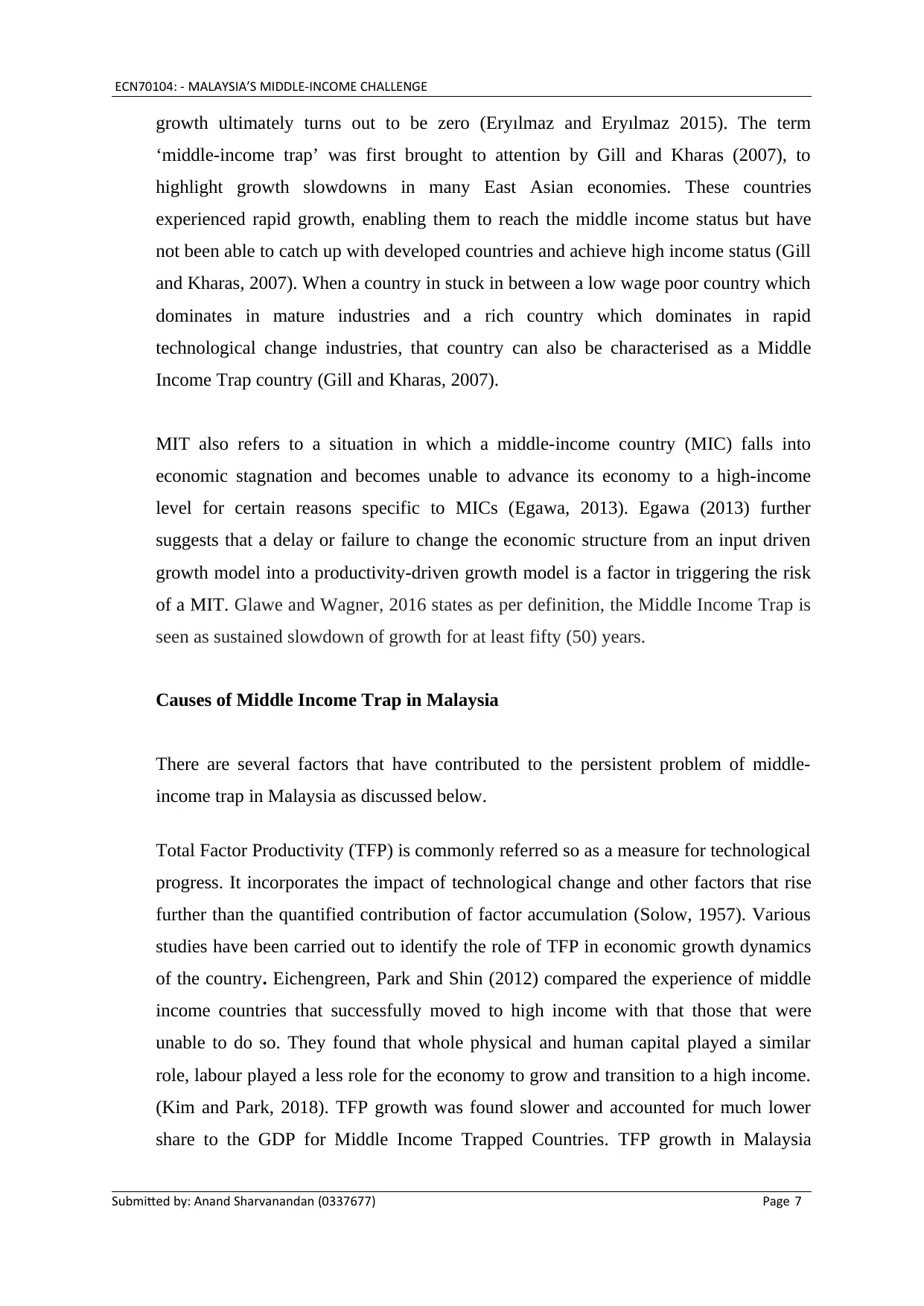
ECN70104: - MALAYSIA’S MIDDLE-INCOME CHALLENGE
growth ultimately turns out to be zero (Eryılmaz and Eryılmaz 2015). The term
‘middle-income trap’ was first brought to attention by Gill and Kharas (2007), to
highlight growth slowdowns in many East Asian economies. These countries
experienced rapid growth, enabling them to reach the middle income status but have
not been able to catch up with developed countries and achieve high income status (Gill
and Kharas, 2007). When a country in stuck in between a low wage poor country which
dominates in mature industries and a rich country which dominates in rapid
technological change industries, that country can also be characterised as a Middle
Income Trap country (Gill and Kharas, 2007).
MIT also refers to a situation in which a middle-income country (MIC) falls into
economic stagnation and becomes unable to advance its economy to a high-income
level for certain reasons specific to MICs (Egawa, 2013). Egawa (2013) further
suggests that a delay or failure to change the economic structure from an input driven
growth model into a productivity-driven growth model is a factor in triggering the risk
of a MIT. Glawe and Wagner, 2016 states as per definition, the Middle Income Trap is
seen as sustained slowdown of growth for at least fifty (50) years.
Causes of Middle Income Trap in Malaysia
There are several factors that have contributed to the persistent problem of middle-
income trap in Malaysia as discussed below.
Total Factor Productivity (TFP) is commonly referred so as a measure for technological
progress. It incorporates the impact of technological change and other factors that rise
further than the quantified contribution of factor accumulation (Solow, 1957). Various
studies have been carried out to identify the role of TFP in economic growth dynamics
of the country. Eichengreen, Park and Shin (2012) compared the experience of middle
income countries that successfully moved to high income with that those that were
unable to do so. They found that whole physical and human capital played a similar
role, labour played a less role for the economy to grow and transition to a high income.
(Kim and Park, 2018). TFP growth was found slower and accounted for much lower
share to the GDP for Middle Income Trapped Countries. TFP growth in Malaysia
Submitted by: Anand Sharvanandan (0337677) Page 7
growth ultimately turns out to be zero (Eryılmaz and Eryılmaz 2015). The term
‘middle-income trap’ was first brought to attention by Gill and Kharas (2007), to
highlight growth slowdowns in many East Asian economies. These countries
experienced rapid growth, enabling them to reach the middle income status but have
not been able to catch up with developed countries and achieve high income status (Gill
and Kharas, 2007). When a country in stuck in between a low wage poor country which
dominates in mature industries and a rich country which dominates in rapid
technological change industries, that country can also be characterised as a Middle
Income Trap country (Gill and Kharas, 2007).
MIT also refers to a situation in which a middle-income country (MIC) falls into
economic stagnation and becomes unable to advance its economy to a high-income
level for certain reasons specific to MICs (Egawa, 2013). Egawa (2013) further
suggests that a delay or failure to change the economic structure from an input driven
growth model into a productivity-driven growth model is a factor in triggering the risk
of a MIT. Glawe and Wagner, 2016 states as per definition, the Middle Income Trap is
seen as sustained slowdown of growth for at least fifty (50) years.
Causes of Middle Income Trap in Malaysia
There are several factors that have contributed to the persistent problem of middle-
income trap in Malaysia as discussed below.
Total Factor Productivity (TFP) is commonly referred so as a measure for technological
progress. It incorporates the impact of technological change and other factors that rise
further than the quantified contribution of factor accumulation (Solow, 1957). Various
studies have been carried out to identify the role of TFP in economic growth dynamics
of the country. Eichengreen, Park and Shin (2012) compared the experience of middle
income countries that successfully moved to high income with that those that were
unable to do so. They found that whole physical and human capital played a similar
role, labour played a less role for the economy to grow and transition to a high income.
(Kim and Park, 2018). TFP growth was found slower and accounted for much lower
share to the GDP for Middle Income Trapped Countries. TFP growth in Malaysia
Submitted by: Anand Sharvanandan (0337677) Page 7
Paraphrase This Document
Need a fresh take? Get an instant paraphrase of this document with our AI Paraphraser
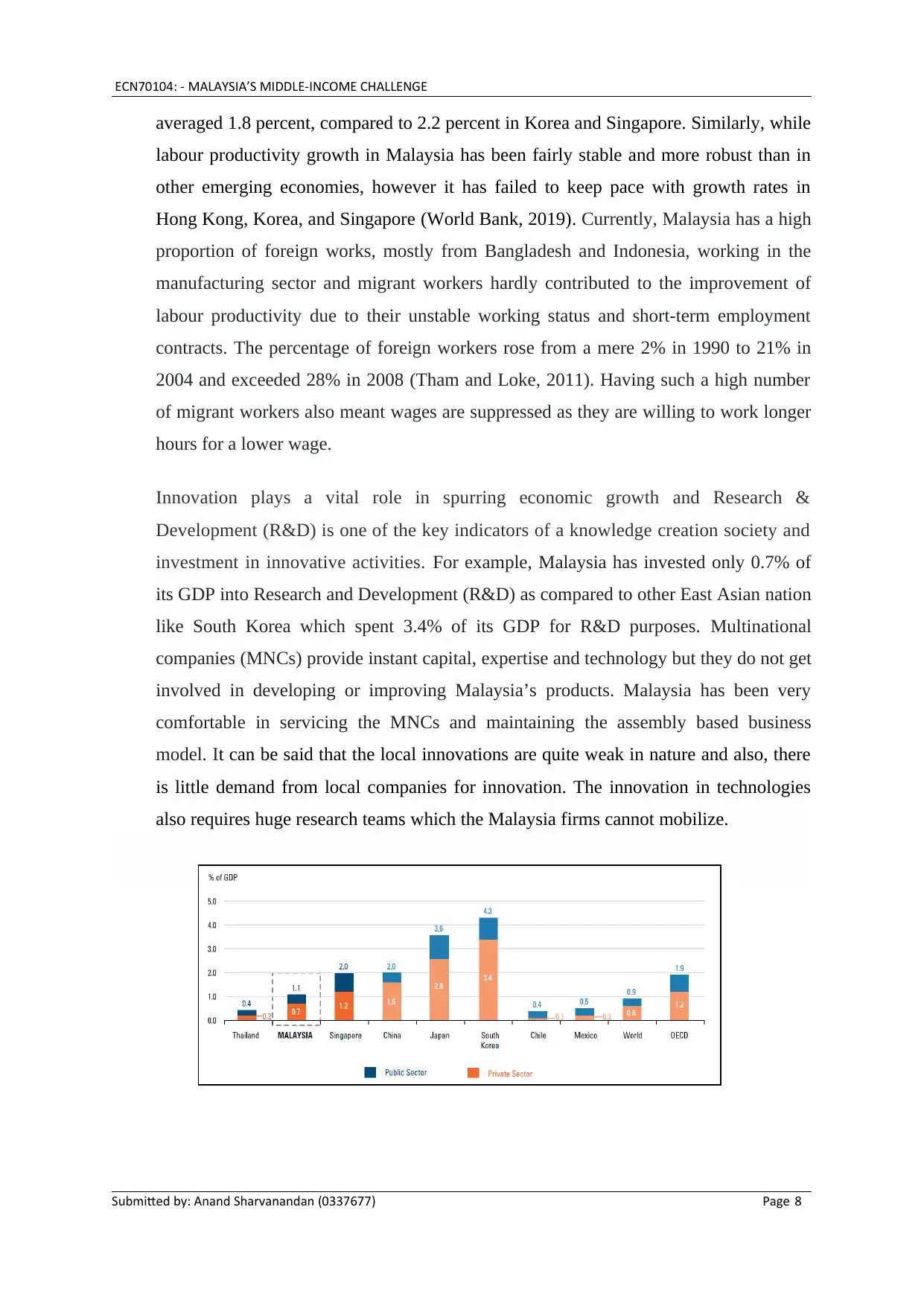
ECN70104: - MALAYSIA’S MIDDLE-INCOME CHALLENGE
averaged 1.8 percent, compared to 2.2 percent in Korea and Singapore. Similarly, while
labour productivity growth in Malaysia has been fairly stable and more robust than in
other emerging economies, however it has failed to keep pace with growth rates in
Hong Kong, Korea, and Singapore (World Bank, 2019). Currently, Malaysia has a high
proportion of foreign works, mostly from Bangladesh and Indonesia, working in the
manufacturing sector and migrant workers hardly contributed to the improvement of
labour productivity due to their unstable working status and short-term employment
contracts. The percentage of foreign workers rose from a mere 2% in 1990 to 21% in
2004 and exceeded 28% in 2008 (Tham and Loke, 2011). Having such a high number
of migrant workers also meant wages are suppressed as they are willing to work longer
hours for a lower wage.
Innovation plays a vital role in spurring economic growth and Research &
Development (R&D) is one of the key indicators of a knowledge creation society and
investment in innovative activities. For example, Malaysia has invested only 0.7% of
its GDP into Research and Development (R&D) as compared to other East Asian nation
like South Korea which spent 3.4% of its GDP for R&D purposes. Multinational
companies (MNCs) provide instant capital, expertise and technology but they do not get
involved in developing or improving Malaysia’s products. Malaysia has been very
comfortable in servicing the MNCs and maintaining the assembly based business
model. It can be said that the local innovations are quite weak in nature and also, there
is little demand from local companies for innovation. The innovation in technologies
also requires huge research teams which the Malaysia firms cannot mobilize.
Submitted by: Anand Sharvanandan (0337677) Page 8
averaged 1.8 percent, compared to 2.2 percent in Korea and Singapore. Similarly, while
labour productivity growth in Malaysia has been fairly stable and more robust than in
other emerging economies, however it has failed to keep pace with growth rates in
Hong Kong, Korea, and Singapore (World Bank, 2019). Currently, Malaysia has a high
proportion of foreign works, mostly from Bangladesh and Indonesia, working in the
manufacturing sector and migrant workers hardly contributed to the improvement of
labour productivity due to their unstable working status and short-term employment
contracts. The percentage of foreign workers rose from a mere 2% in 1990 to 21% in
2004 and exceeded 28% in 2008 (Tham and Loke, 2011). Having such a high number
of migrant workers also meant wages are suppressed as they are willing to work longer
hours for a lower wage.
Innovation plays a vital role in spurring economic growth and Research &
Development (R&D) is one of the key indicators of a knowledge creation society and
investment in innovative activities. For example, Malaysia has invested only 0.7% of
its GDP into Research and Development (R&D) as compared to other East Asian nation
like South Korea which spent 3.4% of its GDP for R&D purposes. Multinational
companies (MNCs) provide instant capital, expertise and technology but they do not get
involved in developing or improving Malaysia’s products. Malaysia has been very
comfortable in servicing the MNCs and maintaining the assembly based business
model. It can be said that the local innovations are quite weak in nature and also, there
is little demand from local companies for innovation. The innovation in technologies
also requires huge research teams which the Malaysia firms cannot mobilize.
Submitted by: Anand Sharvanandan (0337677) Page 8

ECN70104: - MALAYSIA’S MIDDLE-INCOME CHALLENGE
Source: - Global Innovation Index
Figure 6: Gross Expenditure on R&D (Selected Countries- 2015)
Another key indicator for innovation are patent applications, which indicates the ability to
transform ideas into actual products. Malaysia patent applications are significantly lower
compared to high income countries.
Source: - Global Innovation Index
Figure 7: Gross Expenditure on R&D (Selected Countries- 2015)
Shahid Yusuf in his paper “Can Malaysia escape the middle-income trap?” states that Penang
had been successful in attracting foreign direct investments in the electronic industry, the
foreign detect investment had enabled Penang to become a manufacturing hub specializing in
electronics as well as electrical machinery (Yusuf, 2017). Although electronics has emerged
as the strength of the city, it can be said that the product space analysis does not support the
case for high tech development other than the electronics. Also, the absence of the local
industries also plays an important role. Malaysia failed to diversify its exports to other high-
value added export products, partially due to the fact that personnel was not trained enough to
develop new technologies and new products (Yusuf and Nabeshima, 2009). The electric and
electronic sectors which grew into a large industry, drove the Malaysian economy and
accounted for more than 70% of manufactured exports and more than 50% of total experts by
the end of 1990s. The pain was felt after several big players i.e. Seagate, Intel, Motorola and
Dell either closed their plants or shrunk their operations (Yusuf, 2003).
Under the Control Act 1961, subsidy was implemented for items such as petrol, gas, rice,
sugar, salt and other essential commodity items. These subsidies have increased government
Submitted by: Anand Sharvanandan (0337677) Page 9
Source: - Global Innovation Index
Figure 6: Gross Expenditure on R&D (Selected Countries- 2015)
Another key indicator for innovation are patent applications, which indicates the ability to
transform ideas into actual products. Malaysia patent applications are significantly lower
compared to high income countries.
Source: - Global Innovation Index
Figure 7: Gross Expenditure on R&D (Selected Countries- 2015)
Shahid Yusuf in his paper “Can Malaysia escape the middle-income trap?” states that Penang
had been successful in attracting foreign direct investments in the electronic industry, the
foreign detect investment had enabled Penang to become a manufacturing hub specializing in
electronics as well as electrical machinery (Yusuf, 2017). Although electronics has emerged
as the strength of the city, it can be said that the product space analysis does not support the
case for high tech development other than the electronics. Also, the absence of the local
industries also plays an important role. Malaysia failed to diversify its exports to other high-
value added export products, partially due to the fact that personnel was not trained enough to
develop new technologies and new products (Yusuf and Nabeshima, 2009). The electric and
electronic sectors which grew into a large industry, drove the Malaysian economy and
accounted for more than 70% of manufactured exports and more than 50% of total experts by
the end of 1990s. The pain was felt after several big players i.e. Seagate, Intel, Motorola and
Dell either closed their plants or shrunk their operations (Yusuf, 2003).
Under the Control Act 1961, subsidy was implemented for items such as petrol, gas, rice,
sugar, salt and other essential commodity items. These subsidies have increased government
Submitted by: Anand Sharvanandan (0337677) Page 9
⊘ This is a preview!⊘
Do you want full access?
Subscribe today to unlock all pages.

Trusted by 1+ million students worldwide
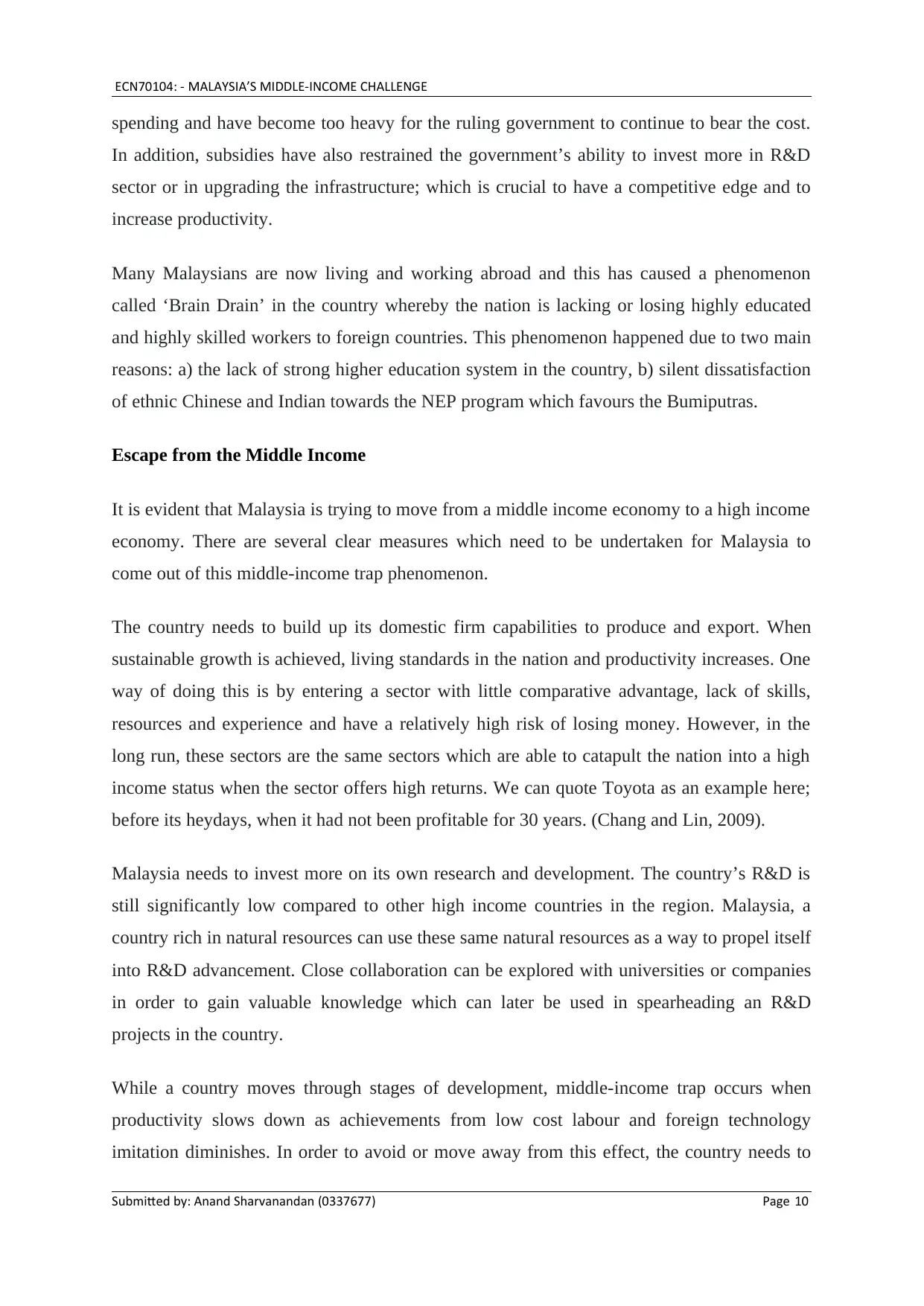
ECN70104: - MALAYSIA’S MIDDLE-INCOME CHALLENGE
spending and have become too heavy for the ruling government to continue to bear the cost.
In addition, subsidies have also restrained the government’s ability to invest more in R&D
sector or in upgrading the infrastructure; which is crucial to have a competitive edge and to
increase productivity.
Many Malaysians are now living and working abroad and this has caused a phenomenon
called ‘Brain Drain’ in the country whereby the nation is lacking or losing highly educated
and highly skilled workers to foreign countries. This phenomenon happened due to two main
reasons: a) the lack of strong higher education system in the country, b) silent dissatisfaction
of ethnic Chinese and Indian towards the NEP program which favours the Bumiputras.
Escape from the Middle Income
It is evident that Malaysia is trying to move from a middle income economy to a high income
economy. There are several clear measures which need to be undertaken for Malaysia to
come out of this middle-income trap phenomenon.
The country needs to build up its domestic firm capabilities to produce and export. When
sustainable growth is achieved, living standards in the nation and productivity increases. One
way of doing this is by entering a sector with little comparative advantage, lack of skills,
resources and experience and have a relatively high risk of losing money. However, in the
long run, these sectors are the same sectors which are able to catapult the nation into a high
income status when the sector offers high returns. We can quote Toyota as an example here;
before its heydays, when it had not been profitable for 30 years. (Chang and Lin, 2009).
Malaysia needs to invest more on its own research and development. The country’s R&D is
still significantly low compared to other high income countries in the region. Malaysia, a
country rich in natural resources can use these same natural resources as a way to propel itself
into R&D advancement. Close collaboration can be explored with universities or companies
in order to gain valuable knowledge which can later be used in spearheading an R&D
projects in the country.
While a country moves through stages of development, middle-income trap occurs when
productivity slows down as achievements from low cost labour and foreign technology
imitation diminishes. In order to avoid or move away from this effect, the country needs to
Submitted by: Anand Sharvanandan (0337677) Page 10
spending and have become too heavy for the ruling government to continue to bear the cost.
In addition, subsidies have also restrained the government’s ability to invest more in R&D
sector or in upgrading the infrastructure; which is crucial to have a competitive edge and to
increase productivity.
Many Malaysians are now living and working abroad and this has caused a phenomenon
called ‘Brain Drain’ in the country whereby the nation is lacking or losing highly educated
and highly skilled workers to foreign countries. This phenomenon happened due to two main
reasons: a) the lack of strong higher education system in the country, b) silent dissatisfaction
of ethnic Chinese and Indian towards the NEP program which favours the Bumiputras.
Escape from the Middle Income
It is evident that Malaysia is trying to move from a middle income economy to a high income
economy. There are several clear measures which need to be undertaken for Malaysia to
come out of this middle-income trap phenomenon.
The country needs to build up its domestic firm capabilities to produce and export. When
sustainable growth is achieved, living standards in the nation and productivity increases. One
way of doing this is by entering a sector with little comparative advantage, lack of skills,
resources and experience and have a relatively high risk of losing money. However, in the
long run, these sectors are the same sectors which are able to catapult the nation into a high
income status when the sector offers high returns. We can quote Toyota as an example here;
before its heydays, when it had not been profitable for 30 years. (Chang and Lin, 2009).
Malaysia needs to invest more on its own research and development. The country’s R&D is
still significantly low compared to other high income countries in the region. Malaysia, a
country rich in natural resources can use these same natural resources as a way to propel itself
into R&D advancement. Close collaboration can be explored with universities or companies
in order to gain valuable knowledge which can later be used in spearheading an R&D
projects in the country.
While a country moves through stages of development, middle-income trap occurs when
productivity slows down as achievements from low cost labour and foreign technology
imitation diminishes. In order to avoid or move away from this effect, the country needs to
Submitted by: Anand Sharvanandan (0337677) Page 10
Paraphrase This Document
Need a fresh take? Get an instant paraphrase of this document with our AI Paraphraser
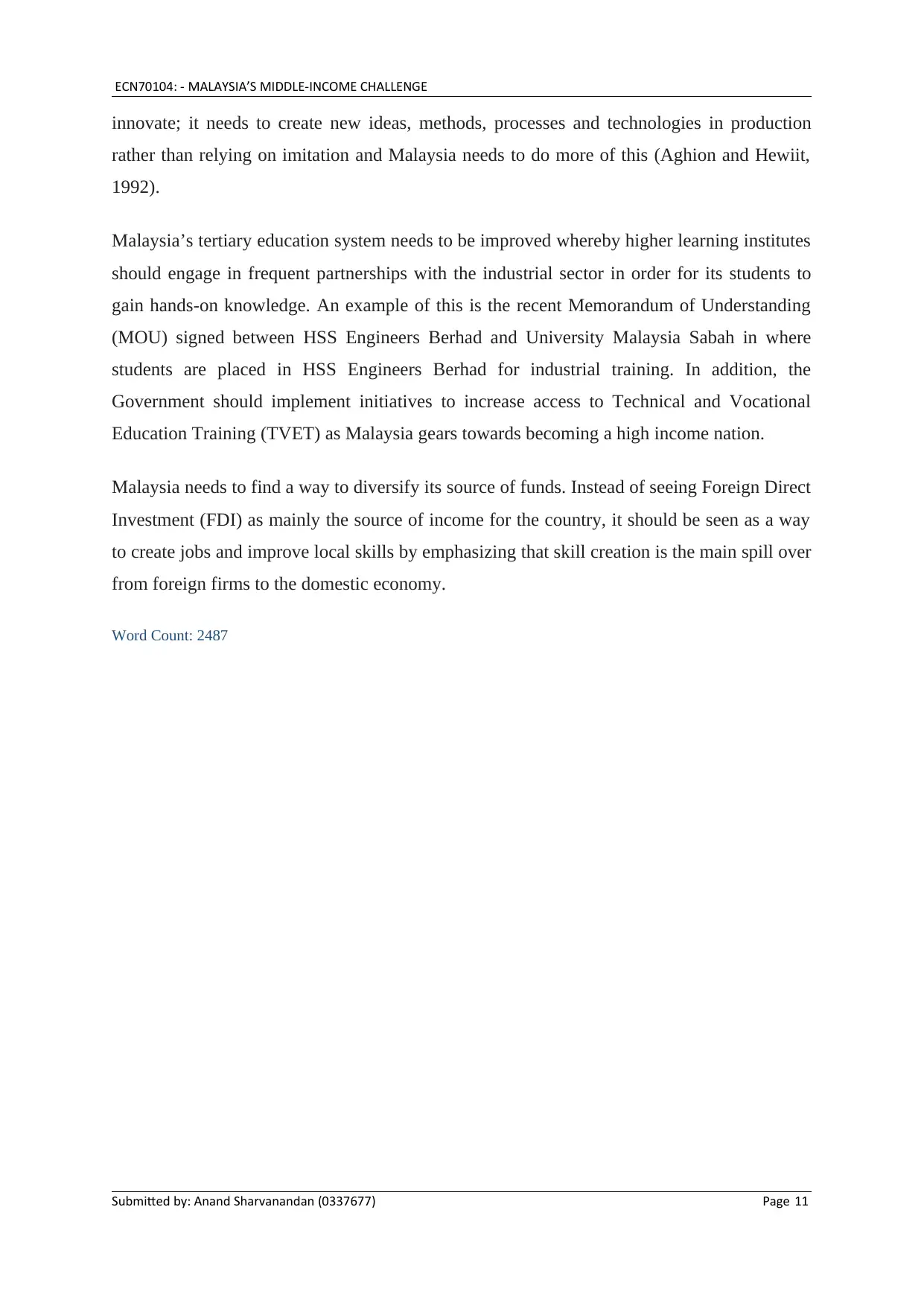
ECN70104: - MALAYSIA’S MIDDLE-INCOME CHALLENGE
innovate; it needs to create new ideas, methods, processes and technologies in production
rather than relying on imitation and Malaysia needs to do more of this (Aghion and Hewiit,
1992).
Malaysia’s tertiary education system needs to be improved whereby higher learning institutes
should engage in frequent partnerships with the industrial sector in order for its students to
gain hands-on knowledge. An example of this is the recent Memorandum of Understanding
(MOU) signed between HSS Engineers Berhad and University Malaysia Sabah in where
students are placed in HSS Engineers Berhad for industrial training. In addition, the
Government should implement initiatives to increase access to Technical and Vocational
Education Training (TVET) as Malaysia gears towards becoming a high income nation.
Malaysia needs to find a way to diversify its source of funds. Instead of seeing Foreign Direct
Investment (FDI) as mainly the source of income for the country, it should be seen as a way
to create jobs and improve local skills by emphasizing that skill creation is the main spill over
from foreign firms to the domestic economy.
Word Count: 2487
Submitted by: Anand Sharvanandan (0337677) Page 11
innovate; it needs to create new ideas, methods, processes and technologies in production
rather than relying on imitation and Malaysia needs to do more of this (Aghion and Hewiit,
1992).
Malaysia’s tertiary education system needs to be improved whereby higher learning institutes
should engage in frequent partnerships with the industrial sector in order for its students to
gain hands-on knowledge. An example of this is the recent Memorandum of Understanding
(MOU) signed between HSS Engineers Berhad and University Malaysia Sabah in where
students are placed in HSS Engineers Berhad for industrial training. In addition, the
Government should implement initiatives to increase access to Technical and Vocational
Education Training (TVET) as Malaysia gears towards becoming a high income nation.
Malaysia needs to find a way to diversify its source of funds. Instead of seeing Foreign Direct
Investment (FDI) as mainly the source of income for the country, it should be seen as a way
to create jobs and improve local skills by emphasizing that skill creation is the main spill over
from foreign firms to the domestic economy.
Word Count: 2487
Submitted by: Anand Sharvanandan (0337677) Page 11
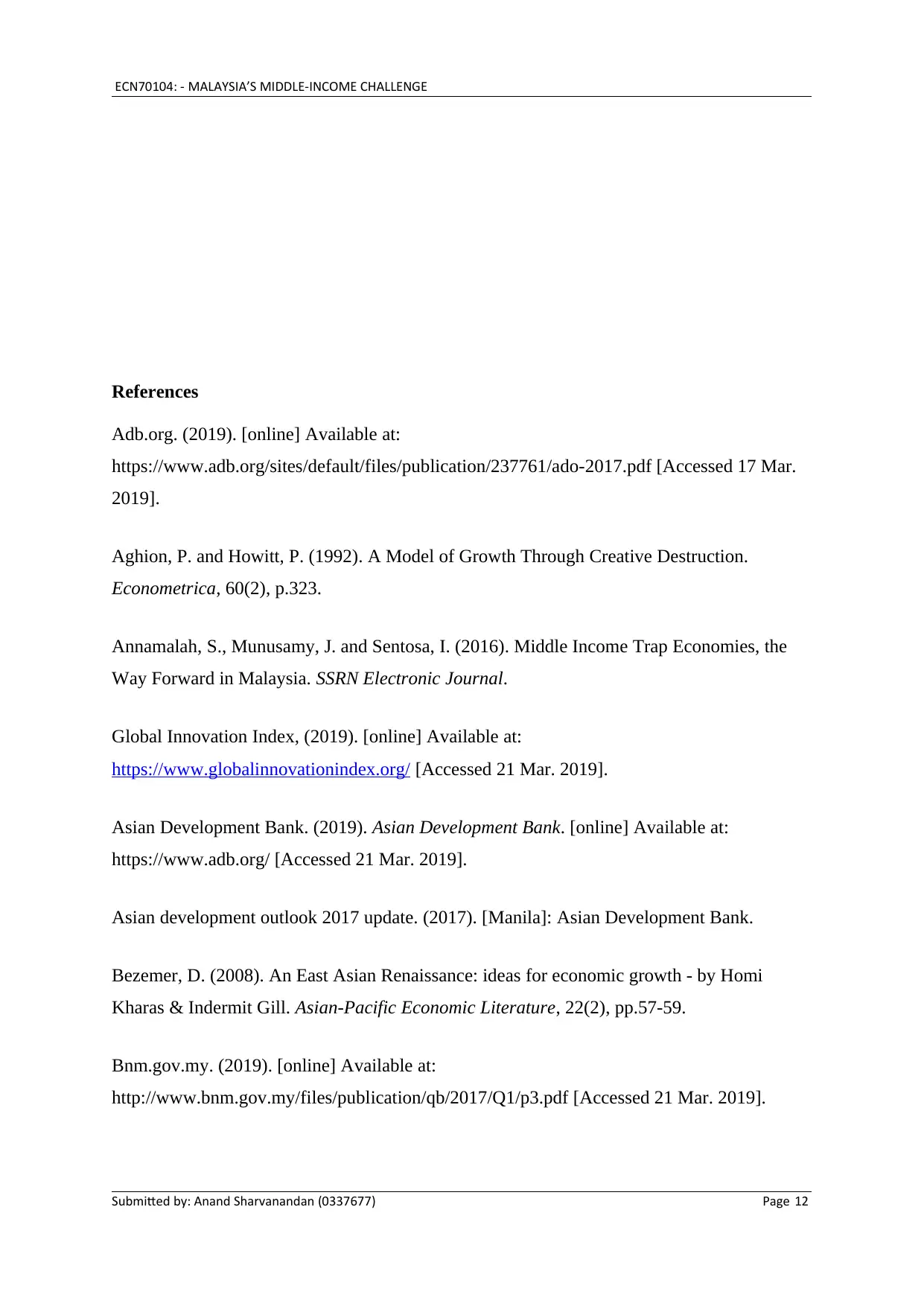
ECN70104: - MALAYSIA’S MIDDLE-INCOME CHALLENGE
References
Adb.org. (2019). [online] Available at:
https://www.adb.org/sites/default/files/publication/237761/ado-2017.pdf [Accessed 17 Mar.
2019].
Aghion, P. and Howitt, P. (1992). A Model of Growth Through Creative Destruction.
Econometrica, 60(2), p.323.
Annamalah, S., Munusamy, J. and Sentosa, I. (2016). Middle Income Trap Economies, the
Way Forward in Malaysia. SSRN Electronic Journal.
Global Innovation Index, (2019). [online] Available at:
https://www.globalinnovationindex.org/ [Accessed 21 Mar. 2019].
Asian Development Bank. (2019). Asian Development Bank. [online] Available at:
https://www.adb.org/ [Accessed 21 Mar. 2019].
Asian development outlook 2017 update. (2017). [Manila]: Asian Development Bank.
Bezemer, D. (2008). An East Asian Renaissance: ideas for economic growth - by Homi
Kharas & Indermit Gill. Asian-Pacific Economic Literature, 22(2), pp.57-59.
Bnm.gov.my. (2019). [online] Available at:
http://www.bnm.gov.my/files/publication/qb/2017/Q1/p3.pdf [Accessed 21 Mar. 2019].
Submitted by: Anand Sharvanandan (0337677) Page 12
References
Adb.org. (2019). [online] Available at:
https://www.adb.org/sites/default/files/publication/237761/ado-2017.pdf [Accessed 17 Mar.
2019].
Aghion, P. and Howitt, P. (1992). A Model of Growth Through Creative Destruction.
Econometrica, 60(2), p.323.
Annamalah, S., Munusamy, J. and Sentosa, I. (2016). Middle Income Trap Economies, the
Way Forward in Malaysia. SSRN Electronic Journal.
Global Innovation Index, (2019). [online] Available at:
https://www.globalinnovationindex.org/ [Accessed 21 Mar. 2019].
Asian Development Bank. (2019). Asian Development Bank. [online] Available at:
https://www.adb.org/ [Accessed 21 Mar. 2019].
Asian development outlook 2017 update. (2017). [Manila]: Asian Development Bank.
Bezemer, D. (2008). An East Asian Renaissance: ideas for economic growth - by Homi
Kharas & Indermit Gill. Asian-Pacific Economic Literature, 22(2), pp.57-59.
Bnm.gov.my. (2019). [online] Available at:
http://www.bnm.gov.my/files/publication/qb/2017/Q1/p3.pdf [Accessed 21 Mar. 2019].
Submitted by: Anand Sharvanandan (0337677) Page 12
⊘ This is a preview!⊘
Do you want full access?
Subscribe today to unlock all pages.

Trusted by 1+ million students worldwide
1 out of 15
Your All-in-One AI-Powered Toolkit for Academic Success.
+13062052269
info@desklib.com
Available 24*7 on WhatsApp / Email
![[object Object]](/_next/static/media/star-bottom.7253800d.svg)
Unlock your academic potential
Copyright © 2020–2026 A2Z Services. All Rights Reserved. Developed and managed by ZUCOL.


